Management Report: Organisational Structure, Functions and Change
VerifiedAdded on 2022/12/30
|9
|2043
|95
Report
AI Summary
This report provides an overview of management concepts, using Marks and Spencer as a case study. It begins by defining organizational structure and its impact on operations, differentiating between functional structures. The report then outlines key management functions, including planning, organizing, staffing, directing, and controlling. It explores the relationship between marketing and other departments such as finance and operations. A significant portion of the report is dedicated to the business environment, analyzing internal and external factors using tools like SWOT and PESTEL. Change management is also discussed, including different types of organizational change and leadership principles. Finally, the report delves into talent management, emphasizing the importance of organizational culture and human resource management for attracting and retaining employees. The report concludes by summarizing the discussed concepts.
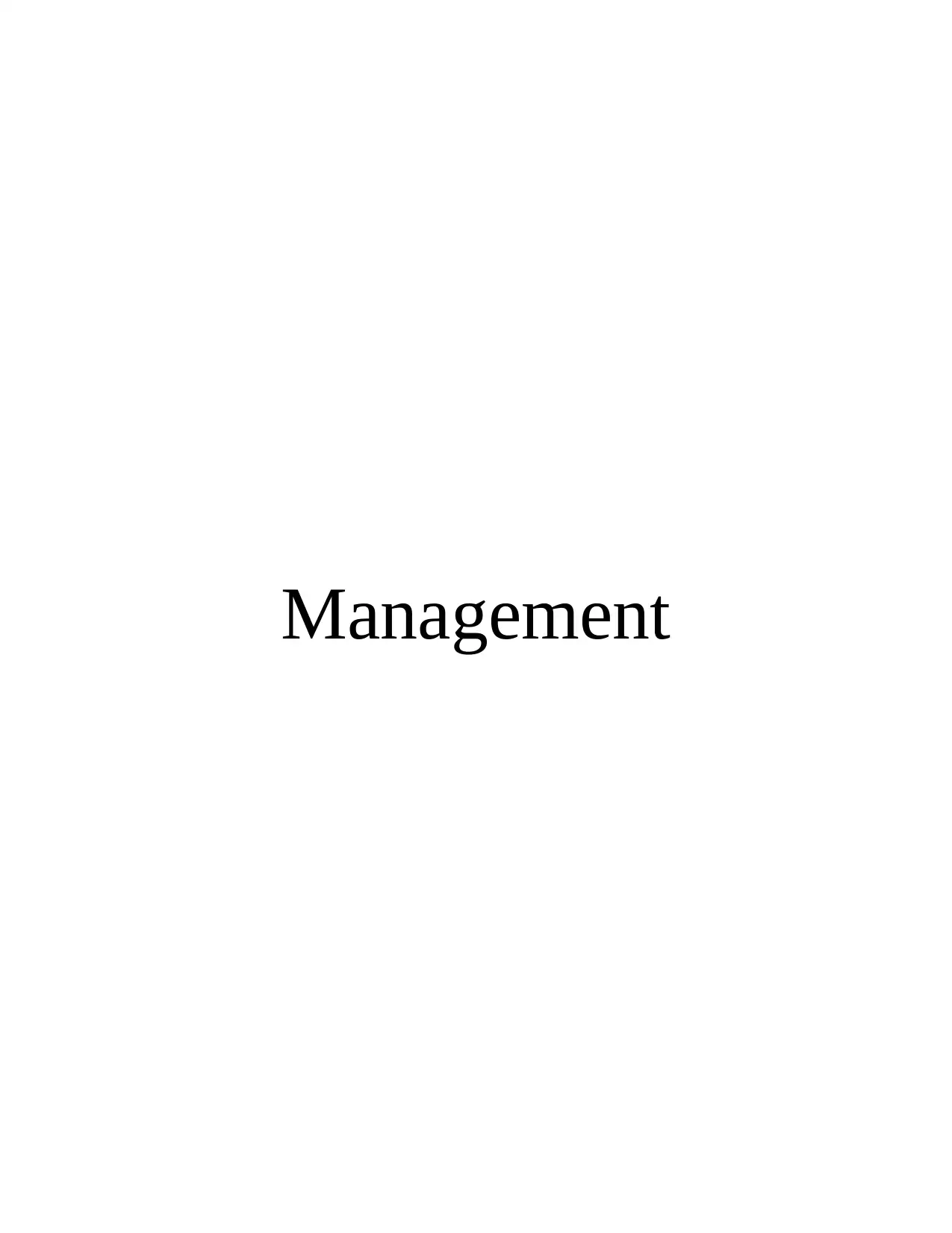
Management
Paraphrase This Document
Need a fresh take? Get an instant paraphrase of this document with our AI Paraphraser

Contents
INTRODUCTION...........................................................................................................................................3
TASK 1..........................................................................................................................................................3
Organisational structure and Management.............................................................................................3
TASK2...........................................................................................................................................................4
Management functions............................................................................................................................4
TASK3...........................................................................................................................................................4
Relation of marketing with other departments.......................................................................................4
The Business environment.......................................................................................................................5
TASK4...........................................................................................................................................................6
Managing and leading a change..............................................................................................................6
Talent management.................................................................................................................................7
CONCLUSION...............................................................................................................................................8
REFERENCES................................................................................................................................................9
INTRODUCTION...........................................................................................................................................3
TASK 1..........................................................................................................................................................3
Organisational structure and Management.............................................................................................3
TASK2...........................................................................................................................................................4
Management functions............................................................................................................................4
TASK3...........................................................................................................................................................4
Relation of marketing with other departments.......................................................................................4
The Business environment.......................................................................................................................5
TASK4...........................................................................................................................................................6
Managing and leading a change..............................................................................................................6
Talent management.................................................................................................................................7
CONCLUSION...............................................................................................................................................8
REFERENCES................................................................................................................................................9
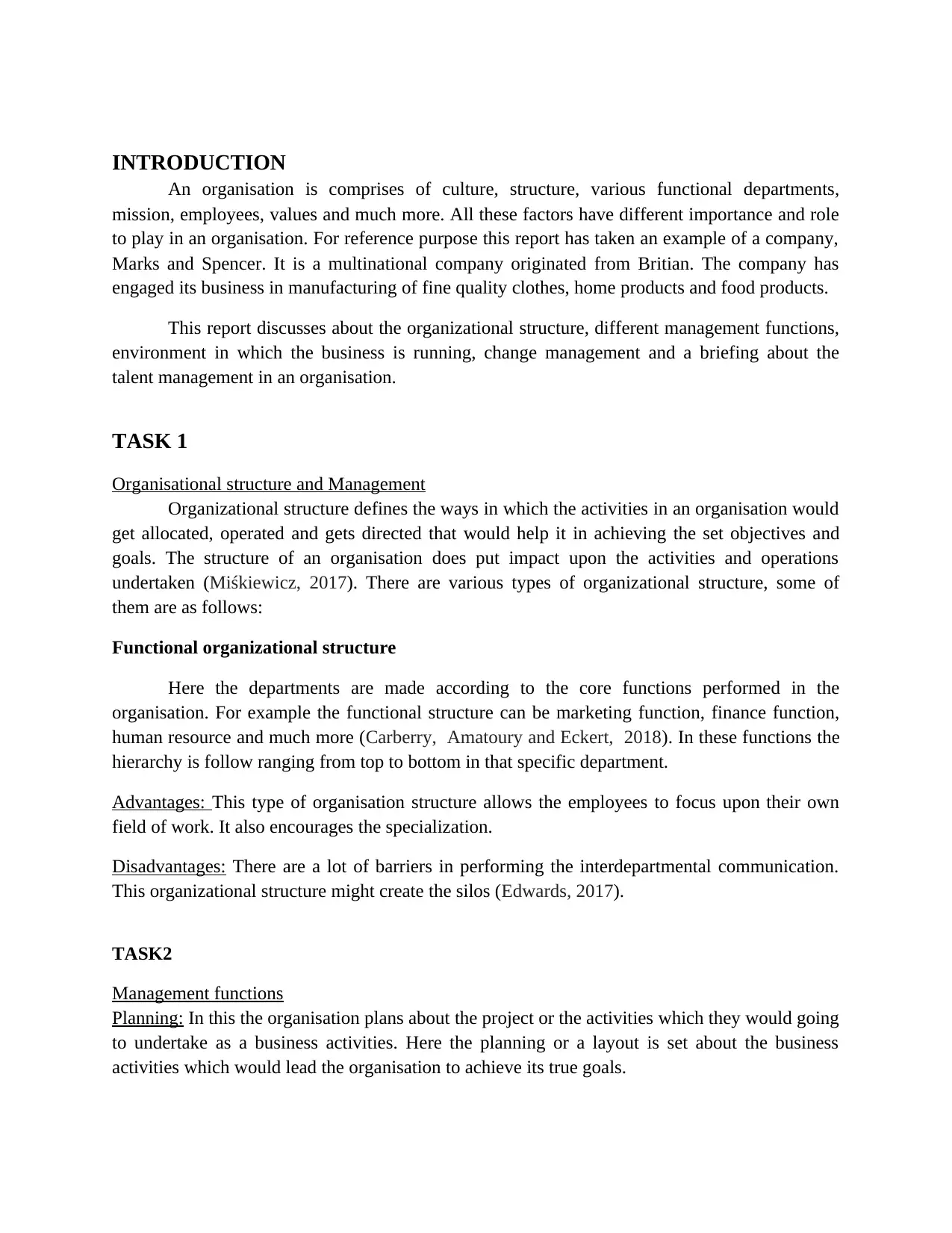
INTRODUCTION
An organisation is comprises of culture, structure, various functional departments,
mission, employees, values and much more. All these factors have different importance and role
to play in an organisation. For reference purpose this report has taken an example of a company,
Marks and Spencer. It is a multinational company originated from Britian. The company has
engaged its business in manufacturing of fine quality clothes, home products and food products.
This report discusses about the organizational structure, different management functions,
environment in which the business is running, change management and a briefing about the
talent management in an organisation.
TASK 1
Organisational structure and Management
Organizational structure defines the ways in which the activities in an organisation would
get allocated, operated and gets directed that would help it in achieving the set objectives and
goals. The structure of an organisation does put impact upon the activities and operations
undertaken (Miśkiewicz, 2017). There are various types of organizational structure, some of
them are as follows:
Functional organizational structure
Here the departments are made according to the core functions performed in the
organisation. For example the functional structure can be marketing function, finance function,
human resource and much more (Carberry, Amatoury and Eckert, 2018). In these functions the
hierarchy is follow ranging from top to bottom in that specific department.
Advantages: This type of organisation structure allows the employees to focus upon their own
field of work. It also encourages the specialization.
Disadvantages: There are a lot of barriers in performing the interdepartmental communication.
This organizational structure might create the silos (Edwards, 2017).
TASK2
Management functions
Planning: In this the organisation plans about the project or the activities which they would going
to undertake as a business activities. Here the planning or a layout is set about the business
activities which would lead the organisation to achieve its true goals.
An organisation is comprises of culture, structure, various functional departments,
mission, employees, values and much more. All these factors have different importance and role
to play in an organisation. For reference purpose this report has taken an example of a company,
Marks and Spencer. It is a multinational company originated from Britian. The company has
engaged its business in manufacturing of fine quality clothes, home products and food products.
This report discusses about the organizational structure, different management functions,
environment in which the business is running, change management and a briefing about the
talent management in an organisation.
TASK 1
Organisational structure and Management
Organizational structure defines the ways in which the activities in an organisation would
get allocated, operated and gets directed that would help it in achieving the set objectives and
goals. The structure of an organisation does put impact upon the activities and operations
undertaken (Miśkiewicz, 2017). There are various types of organizational structure, some of
them are as follows:
Functional organizational structure
Here the departments are made according to the core functions performed in the
organisation. For example the functional structure can be marketing function, finance function,
human resource and much more (Carberry, Amatoury and Eckert, 2018). In these functions the
hierarchy is follow ranging from top to bottom in that specific department.
Advantages: This type of organisation structure allows the employees to focus upon their own
field of work. It also encourages the specialization.
Disadvantages: There are a lot of barriers in performing the interdepartmental communication.
This organizational structure might create the silos (Edwards, 2017).
TASK2
Management functions
Planning: In this the organisation plans about the project or the activities which they would going
to undertake as a business activities. Here the planning or a layout is set about the business
activities which would lead the organisation to achieve its true goals.
⊘ This is a preview!⊘
Do you want full access?
Subscribe today to unlock all pages.

Trusted by 1+ million students worldwide

Organizing: It is an activity in which the resources which are needed to implement or pursue the
plan gets organized by the organisation. This may include forming the structure, collection of
required resources and the like.
Staffing: It is an activity in which the organisation like Marks and Spencer collects or acquired
the talented workforce in their organisation so that they these people can help the organisation in
achieving their goals and objectives.
Directing: It is concerned with monitoring the activities of employees in the direction which
could lead to the accomplishment of goals.
Controlling: It is an activity in which the controlling measures takes place in such a way that
bridges the gap between the actual and standard goals. Controlling function involves the
monitoring and evaluation of tasks. To evaluate tasks, manager should measure performance in
comparison with the standard and expectation they set. That is, controlling function assess
whether the plans set within the planning function are achieved (Madura, 2007: 252).
TASK3
Relation of marketing with other departments
Marketing & finance: This function of accounting department of business organisation is relating
to communicate financial position which is responsible for ensuring efficient financial
management of the firm. Financial department figure out how to add value within organisation
and helps marketing department in funding for performing marketing functions.
Marketing & operation: Marketing department of respective firm ensures the customers needs
and market competition and trends that are important for successful running of business. Then
operation and production department follows the guidelines of marketing department and
produce the outcome as per the requirement that reflects effective business results.
The Business environment
There are various tools through which the internal environment of Marks and
Spencer Company can get evaluated. One of such tool is SWOT, which can be as:
Strengths
The company is spread throughout the
world and has a strong operational
network.
Weakness
The designs of their clothes
manufactured by the organisation are
not that new and catchy.
Opportunities
The company has the opportunity to
expand its business in the areas where it
has not set its step yet.
Threats
The increase in the degree of
competition is the major factor for
threat.
One of those tools is PESTEL which can be as follows:
plan gets organized by the organisation. This may include forming the structure, collection of
required resources and the like.
Staffing: It is an activity in which the organisation like Marks and Spencer collects or acquired
the talented workforce in their organisation so that they these people can help the organisation in
achieving their goals and objectives.
Directing: It is concerned with monitoring the activities of employees in the direction which
could lead to the accomplishment of goals.
Controlling: It is an activity in which the controlling measures takes place in such a way that
bridges the gap between the actual and standard goals. Controlling function involves the
monitoring and evaluation of tasks. To evaluate tasks, manager should measure performance in
comparison with the standard and expectation they set. That is, controlling function assess
whether the plans set within the planning function are achieved (Madura, 2007: 252).
TASK3
Relation of marketing with other departments
Marketing & finance: This function of accounting department of business organisation is relating
to communicate financial position which is responsible for ensuring efficient financial
management of the firm. Financial department figure out how to add value within organisation
and helps marketing department in funding for performing marketing functions.
Marketing & operation: Marketing department of respective firm ensures the customers needs
and market competition and trends that are important for successful running of business. Then
operation and production department follows the guidelines of marketing department and
produce the outcome as per the requirement that reflects effective business results.
The Business environment
There are various tools through which the internal environment of Marks and
Spencer Company can get evaluated. One of such tool is SWOT, which can be as:
Strengths
The company is spread throughout the
world and has a strong operational
network.
Weakness
The designs of their clothes
manufactured by the organisation are
not that new and catchy.
Opportunities
The company has the opportunity to
expand its business in the areas where it
has not set its step yet.
Threats
The increase in the degree of
competition is the major factor for
threat.
One of those tools is PESTEL which can be as follows:
Paraphrase This Document
Need a fresh take? Get an instant paraphrase of this document with our AI Paraphraser
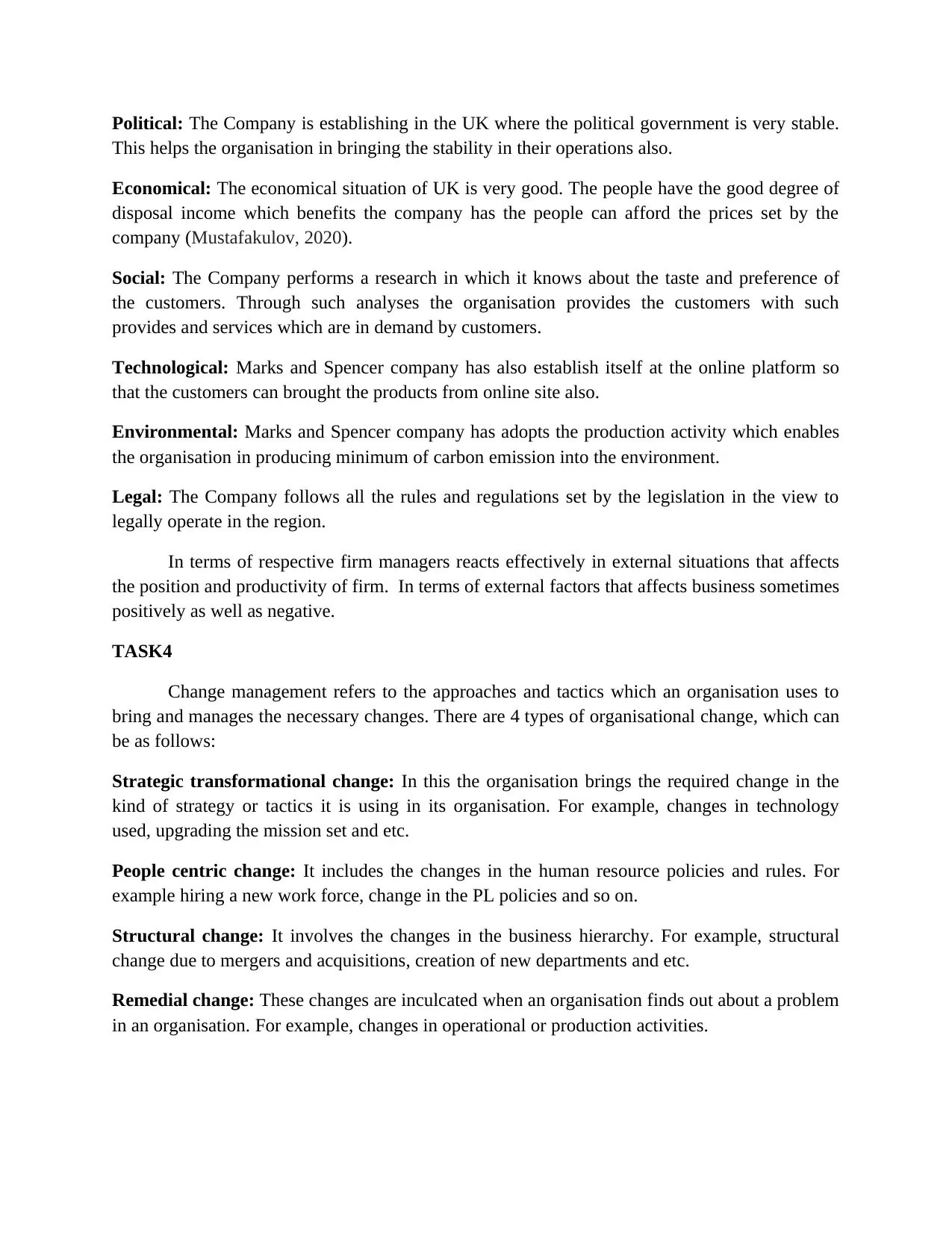
Political: The Company is establishing in the UK where the political government is very stable.
This helps the organisation in bringing the stability in their operations also.
Economical: The economical situation of UK is very good. The people have the good degree of
disposal income which benefits the company has the people can afford the prices set by the
company (Mustafakulov, 2020).
Social: The Company performs a research in which it knows about the taste and preference of
the customers. Through such analyses the organisation provides the customers with such
provides and services which are in demand by customers.
Technological: Marks and Spencer company has also establish itself at the online platform so
that the customers can brought the products from online site also.
Environmental: Marks and Spencer company has adopts the production activity which enables
the organisation in producing minimum of carbon emission into the environment.
Legal: The Company follows all the rules and regulations set by the legislation in the view to
legally operate in the region.
In terms of respective firm managers reacts effectively in external situations that affects
the position and productivity of firm. In terms of external factors that affects business sometimes
positively as well as negative.
TASK4
Change management refers to the approaches and tactics which an organisation uses to
bring and manages the necessary changes. There are 4 types of organisational change, which can
be as follows:
Strategic transformational change: In this the organisation brings the required change in the
kind of strategy or tactics it is using in its organisation. For example, changes in technology
used, upgrading the mission set and etc.
People centric change: It includes the changes in the human resource policies and rules. For
example hiring a new work force, change in the PL policies and so on.
Structural change: It involves the changes in the business hierarchy. For example, structural
change due to mergers and acquisitions, creation of new departments and etc.
Remedial change: These changes are inculcated when an organisation finds out about a problem
in an organisation. For example, changes in operational or production activities.
This helps the organisation in bringing the stability in their operations also.
Economical: The economical situation of UK is very good. The people have the good degree of
disposal income which benefits the company has the people can afford the prices set by the
company (Mustafakulov, 2020).
Social: The Company performs a research in which it knows about the taste and preference of
the customers. Through such analyses the organisation provides the customers with such
provides and services which are in demand by customers.
Technological: Marks and Spencer company has also establish itself at the online platform so
that the customers can brought the products from online site also.
Environmental: Marks and Spencer company has adopts the production activity which enables
the organisation in producing minimum of carbon emission into the environment.
Legal: The Company follows all the rules and regulations set by the legislation in the view to
legally operate in the region.
In terms of respective firm managers reacts effectively in external situations that affects
the position and productivity of firm. In terms of external factors that affects business sometimes
positively as well as negative.
TASK4
Change management refers to the approaches and tactics which an organisation uses to
bring and manages the necessary changes. There are 4 types of organisational change, which can
be as follows:
Strategic transformational change: In this the organisation brings the required change in the
kind of strategy or tactics it is using in its organisation. For example, changes in technology
used, upgrading the mission set and etc.
People centric change: It includes the changes in the human resource policies and rules. For
example hiring a new work force, change in the PL policies and so on.
Structural change: It involves the changes in the business hierarchy. For example, structural
change due to mergers and acquisitions, creation of new departments and etc.
Remedial change: These changes are inculcated when an organisation finds out about a problem
in an organisation. For example, changes in operational or production activities.
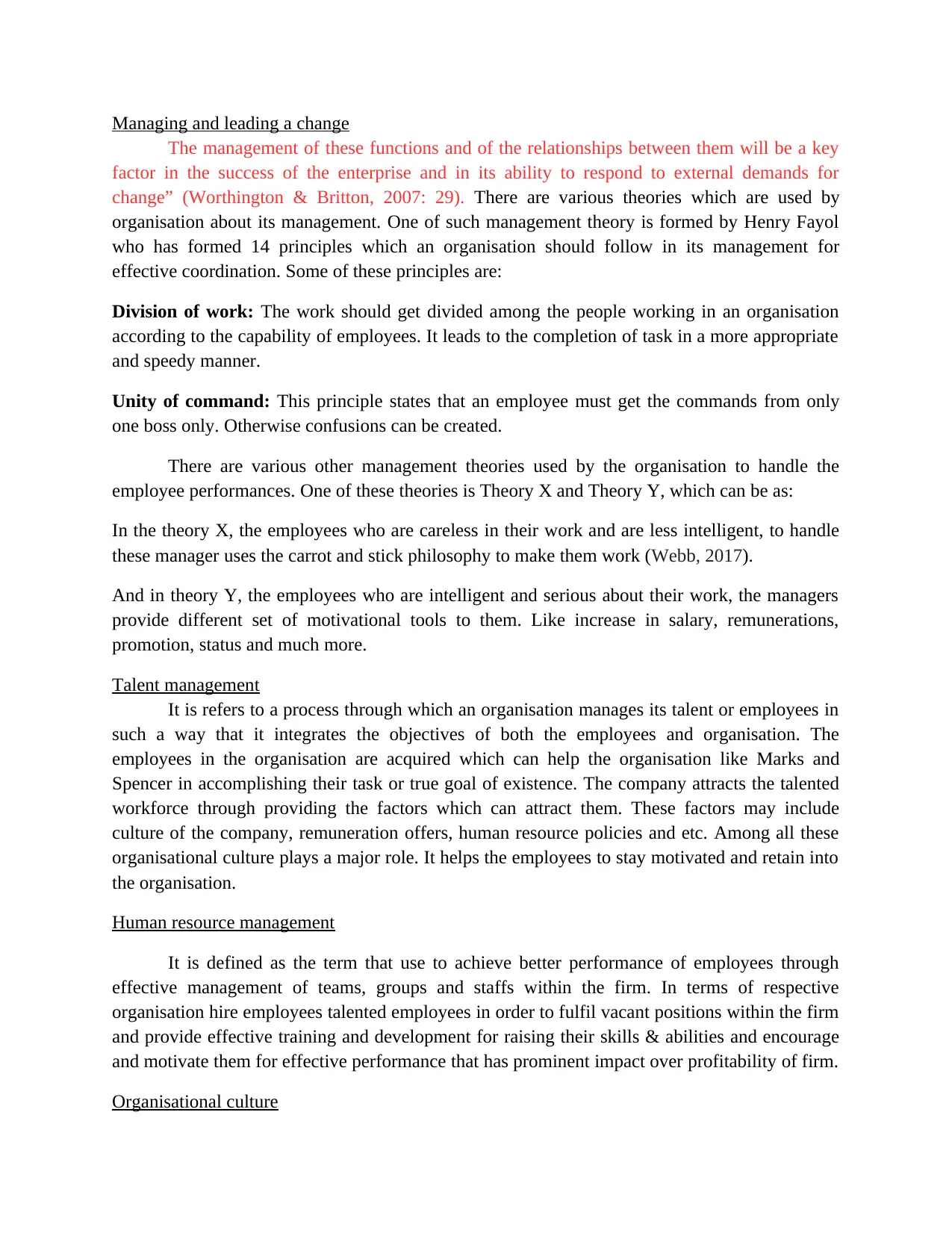
Managing and leading a change
The management of these functions and of the relationships between them will be a key
factor in the success of the enterprise and in its ability to respond to external demands for
change” (Worthington & Britton, 2007: 29). There are various theories which are used by
organisation about its management. One of such management theory is formed by Henry Fayol
who has formed 14 principles which an organisation should follow in its management for
effective coordination. Some of these principles are:
Division of work: The work should get divided among the people working in an organisation
according to the capability of employees. It leads to the completion of task in a more appropriate
and speedy manner.
Unity of command: This principle states that an employee must get the commands from only
one boss only. Otherwise confusions can be created.
There are various other management theories used by the organisation to handle the
employee performances. One of these theories is Theory X and Theory Y, which can be as:
In the theory X, the employees who are careless in their work and are less intelligent, to handle
these manager uses the carrot and stick philosophy to make them work (Webb, 2017).
And in theory Y, the employees who are intelligent and serious about their work, the managers
provide different set of motivational tools to them. Like increase in salary, remunerations,
promotion, status and much more.
Talent management
It is refers to a process through which an organisation manages its talent or employees in
such a way that it integrates the objectives of both the employees and organisation. The
employees in the organisation are acquired which can help the organisation like Marks and
Spencer in accomplishing their task or true goal of existence. The company attracts the talented
workforce through providing the factors which can attract them. These factors may include
culture of the company, remuneration offers, human resource policies and etc. Among all these
organisational culture plays a major role. It helps the employees to stay motivated and retain into
the organisation.
Human resource management
It is defined as the term that use to achieve better performance of employees through
effective management of teams, groups and staffs within the firm. In terms of respective
organisation hire employees talented employees in order to fulfil vacant positions within the firm
and provide effective training and development for raising their skills & abilities and encourage
and motivate them for effective performance that has prominent impact over profitability of firm.
Organisational culture
The management of these functions and of the relationships between them will be a key
factor in the success of the enterprise and in its ability to respond to external demands for
change” (Worthington & Britton, 2007: 29). There are various theories which are used by
organisation about its management. One of such management theory is formed by Henry Fayol
who has formed 14 principles which an organisation should follow in its management for
effective coordination. Some of these principles are:
Division of work: The work should get divided among the people working in an organisation
according to the capability of employees. It leads to the completion of task in a more appropriate
and speedy manner.
Unity of command: This principle states that an employee must get the commands from only
one boss only. Otherwise confusions can be created.
There are various other management theories used by the organisation to handle the
employee performances. One of these theories is Theory X and Theory Y, which can be as:
In the theory X, the employees who are careless in their work and are less intelligent, to handle
these manager uses the carrot and stick philosophy to make them work (Webb, 2017).
And in theory Y, the employees who are intelligent and serious about their work, the managers
provide different set of motivational tools to them. Like increase in salary, remunerations,
promotion, status and much more.
Talent management
It is refers to a process through which an organisation manages its talent or employees in
such a way that it integrates the objectives of both the employees and organisation. The
employees in the organisation are acquired which can help the organisation like Marks and
Spencer in accomplishing their task or true goal of existence. The company attracts the talented
workforce through providing the factors which can attract them. These factors may include
culture of the company, remuneration offers, human resource policies and etc. Among all these
organisational culture plays a major role. It helps the employees to stay motivated and retain into
the organisation.
Human resource management
It is defined as the term that use to achieve better performance of employees through
effective management of teams, groups and staffs within the firm. In terms of respective
organisation hire employees talented employees in order to fulfil vacant positions within the firm
and provide effective training and development for raising their skills & abilities and encourage
and motivate them for effective performance that has prominent impact over profitability of firm.
Organisational culture
⊘ This is a preview!⊘
Do you want full access?
Subscribe today to unlock all pages.

Trusted by 1+ million students worldwide
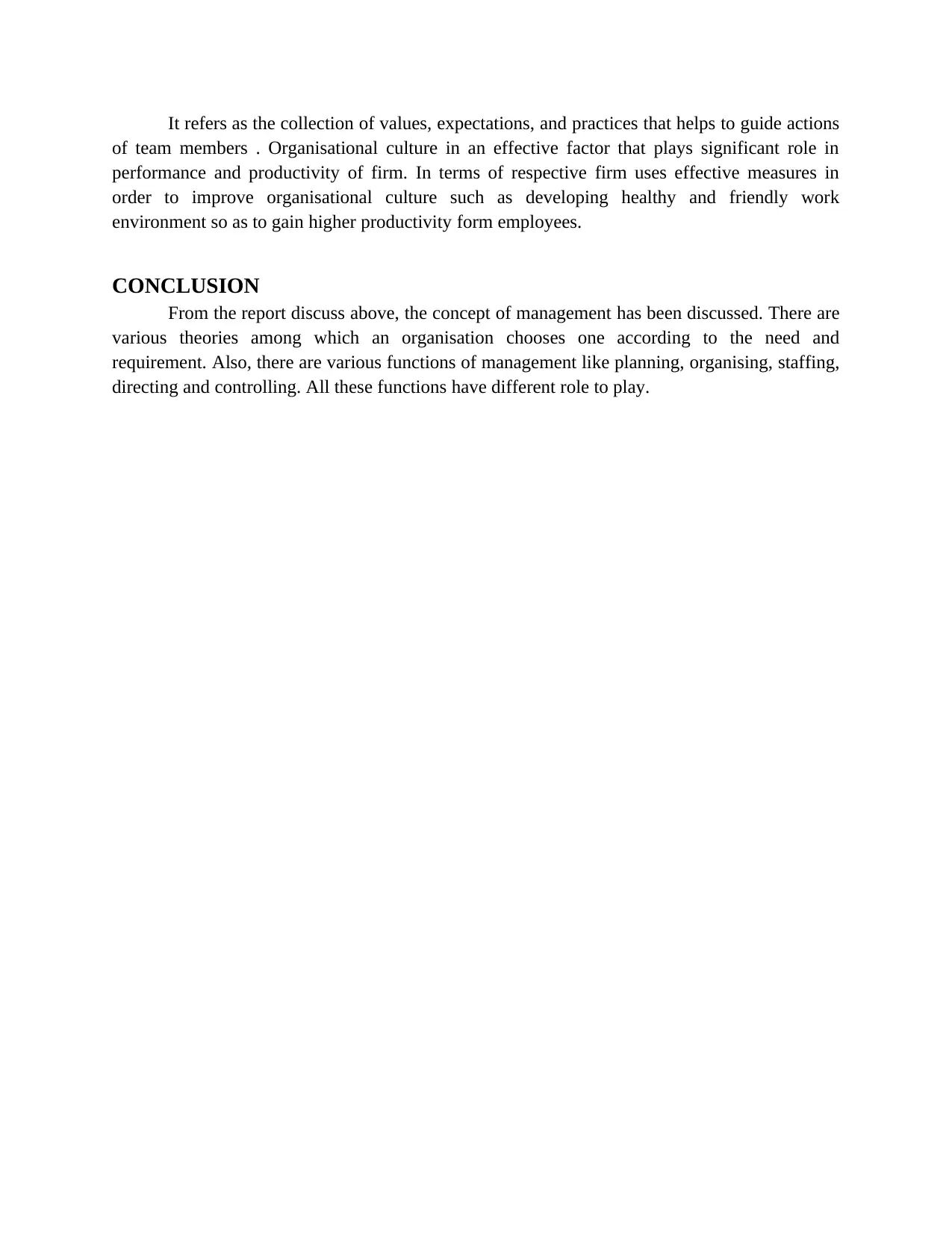
It refers as the collection of values, expectations, and practices that helps to guide actions
of team members . Organisational culture in an effective factor that plays significant role in
performance and productivity of firm. In terms of respective firm uses effective measures in
order to improve organisational culture such as developing healthy and friendly work
environment so as to gain higher productivity form employees.
CONCLUSION
From the report discuss above, the concept of management has been discussed. There are
various theories among which an organisation chooses one according to the need and
requirement. Also, there are various functions of management like planning, organising, staffing,
directing and controlling. All these functions have different role to play.
of team members . Organisational culture in an effective factor that plays significant role in
performance and productivity of firm. In terms of respective firm uses effective measures in
order to improve organisational culture such as developing healthy and friendly work
environment so as to gain higher productivity form employees.
CONCLUSION
From the report discuss above, the concept of management has been discussed. There are
various theories among which an organisation chooses one according to the need and
requirement. Also, there are various functions of management like planning, organising, staffing,
directing and controlling. All these functions have different role to play.
Paraphrase This Document
Need a fresh take? Get an instant paraphrase of this document with our AI Paraphraser

REFERENCES
Books and Journals
Bloom, N.,and et al., 2017. What drives differences in management? (No. w23300). National
Bureau of Economic Research.
Carberry, J. C., Amatoury, J. and Eckert, D. J., 2018. Personalized management approach for
OSA. Chest. 153(3). pp.744-755.
Edwards, S. D., 2017. Management in Eastern Europe. Macmillan International Higher
Education.
Faust, J. S. and Weingart, S. D., 2017. The past, present, and future of the Centers for Medicare
and Medicaid Services quality measure SEP-1: the early management bundle for severe
Sepsis/Septic shock. Emergency Medicine Clinics. 35(1). pp.219-231.
Mustafakulov, S., 2020. Features of the system approach to management of social and economic
development of regions.Архив научных исследований. 1(4).
Vartak, M., and et al., 2016, June. ModelDB: a system for machine learning model management.
In Proceedings of the Workshop on Human-In-the-Loop Data Analytics (pp. 1-3).
Webb, S. P., 2017. Knowledge management: Linchpin of change. Routledge.
Miśkiewicz, R., 2017. Organisational structure in the process of integration on the example of
iron and steel industry enterprises in Poland. Difin.
Books and Journals
Bloom, N.,and et al., 2017. What drives differences in management? (No. w23300). National
Bureau of Economic Research.
Carberry, J. C., Amatoury, J. and Eckert, D. J., 2018. Personalized management approach for
OSA. Chest. 153(3). pp.744-755.
Edwards, S. D., 2017. Management in Eastern Europe. Macmillan International Higher
Education.
Faust, J. S. and Weingart, S. D., 2017. The past, present, and future of the Centers for Medicare
and Medicaid Services quality measure SEP-1: the early management bundle for severe
Sepsis/Septic shock. Emergency Medicine Clinics. 35(1). pp.219-231.
Mustafakulov, S., 2020. Features of the system approach to management of social and economic
development of regions.Архив научных исследований. 1(4).
Vartak, M., and et al., 2016, June. ModelDB: a system for machine learning model management.
In Proceedings of the Workshop on Human-In-the-Loop Data Analytics (pp. 1-3).
Webb, S. P., 2017. Knowledge management: Linchpin of change. Routledge.
Miśkiewicz, R., 2017. Organisational structure in the process of integration on the example of
iron and steel industry enterprises in Poland. Difin.

⊘ This is a preview!⊘
Do you want full access?
Subscribe today to unlock all pages.

Trusted by 1+ million students worldwide
1 out of 9
Related Documents
Your All-in-One AI-Powered Toolkit for Academic Success.
+13062052269
info@desklib.com
Available 24*7 on WhatsApp / Email
![[object Object]](/_next/static/media/star-bottom.7253800d.svg)
Unlock your academic potential
Copyright © 2020–2025 A2Z Services. All Rights Reserved. Developed and managed by ZUCOL.





